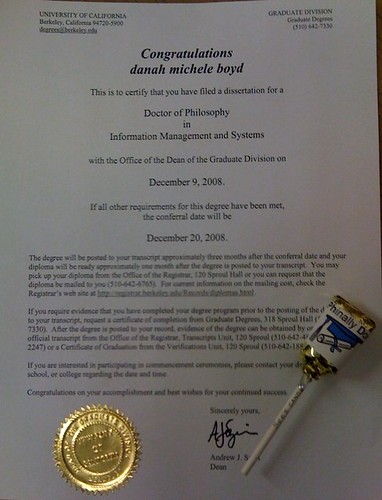A year ago, I teamed up with John Palfrey and Dena Sacco to co-direct the Internet Safety Technical Task Force. I came to this project with the strong conviction that policy concerning children’s safety should be grounded in data. In other words, rather than focus on what might be, it would behoove us to take a look at what is and propose solutions to address known problems in ways that align with the logic and social conditions in which kids live. For years, I had been watching policy unfold that would do nothing to help the hurting kids that I met. I was frustrated and wanted to make a difference.
Going into this Task Force, I was extremely naive. I genuinely believed that people were making bad policy, bad technology, and bad decisions because they lacked the data or knowledge to interpret the data. I was upset that so much research was behind the pearly gates of locked-down journal publishers and that, even when accessed, many people didn’t know how to read that material. I believed that I had a responsibility to make research accessible so that it could be usable. I thought that presenting data would motivate people to innovate and devise solutions to help kids. I was wrong.
I’m not good at politics. I don’t understand the logic that operates behind politics and I cannot lie to myself or others to get my way. I am a scholar. I believe in the pursuit of knowledge, the dissemination of ideas, and the education of all. I entered this project to help people understand what we scholars have been following for a long time, but I got way in over my head.
For the our Task Force Report, I helped create a Research Advisory Board Literature Review where, along with the tremendous help of Andrew Schrock, we aggregated research to highlight the known issues around online safety. The patterns are brutally clear. The same issues continue to emerge with each new technology. The kids who are in trouble offline are more likely to be in trouble online and offline psychosocial factors contribute to online risks. Many more youth experience bullying than sexual contact and the realities of “predation” look very different than most people imagine and, thus, require vastly different solutions than most people propose.
The report was released while I was away and I came home to a storm. I’m used to folks dismissing qualitative work because they don’t understand it, but I’ve never before witnessed so many people reject solid quantitative studies done by reputable organizations that are replicated with different sampling techniques across different studies. Never in my wildest dreams did I expect someone to say to me, “Go find other data.” More frequently, as if in a refrain, folks are trying to reject the studies in this report as “old” and “outdated” even though the report makes it clear that the findings paint a consistent portrait and unreleased data show similar patterns. It’s as if nothing would satiate critics who can’t imagine that the real dangers are different than have been portrayed over the years.
I can think of many reasons for why people refuse to listen to data that conflicts with their perception. But what breaks my heart about this is that folks are doing it in a way that dismisses the thousands of youth who are truly in trouble. This shouldn’t be about whether or not the Internet is “safe” or “not safe” but whether or not the kids are ok. And many of them are NOT ok.
After staring at the data, I strongly believe that we need to stop talking about the Internet as the cause and start talking about it as the megaphone. The Internet makes visible how many kids are not ok. We desperately need an integrated set of compassionate solutions. Digital social workers are needed to reach out to troubled kids and guide them through the rough spots. Law enforcement is vital for tracking down dangerous individuals, but we need to fund them to investigate and prosecute. Parents and educators are desperately needed to be engaged and informed. Technical solutions are needed to support these different actors. But there is no magic silver bullet. The problems that exist cannot be solved by preventing adults from communicating with minors (and there are huge unintended consequences to that… including limiting social workers from helping kids) and they cannot be solved by filtering the content. It’s also critical that we engage youth in the process because many of them are engaging in risky behaviors that put them in the line of danger because of external factors that desperately need to be addressed.
If you’re a parent, a teacher, a law enforcer, or simply a concerned citizen, I beg you to read at least the Executive Summary (if not the whole report). The kids need our support, our attention, and our love. They need us to move away from our fears and address the very real dangers and issues that they face. This isn’t a black and white story. This is a very complex set of issues that require people to get informed.

